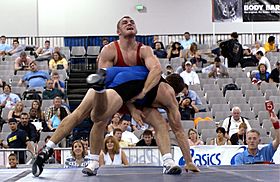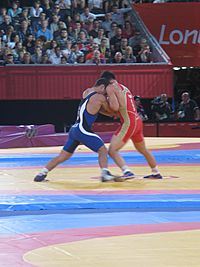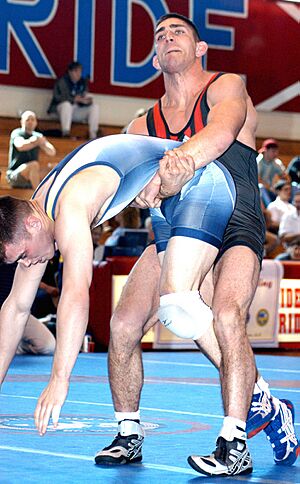Greco-Roman wrestling facts for kids
 |
|
| Also known as | French wrestling (Lutte française), Greco, Flat Hand wrestling |
|---|---|
| Focus | Wrestling, Grappling |
| Hardness | full-contact |
| Country of origin | Europe |
| Creator | Jean Exbrayat |
| Famous practitioners | (see notable practitioners below) |
| Olympic sport | Since 1896 |
| Official website | https://uww.org |
Greco-Roman wrestling is a style of wrestling practiced all over the world. It's also known as classic wrestling or French wrestling. This sport was part of the very first modern Olympic Games in 1896. It has been in almost every Summer Olympics since then.
What makes Greco-Roman wrestling special is that wrestlers are not allowed to grab or attack below the waist. This means they can't trip their opponent or grab their legs. Instead, they focus on powerful throws and upper-body moves. This rule makes it different from freestyle wrestling, which is the other wrestling style in the Olympics.
Greco-Roman wrestling is one of several types of amateur wrestling. These sports are overseen by an organization called United World Wrestling. Other wrestling styles include men's and women's freestyle wrestling, grappling, and beach wrestling.
Contents
History of Greco-Roman Wrestling
The name "Greco-Roman" was chosen to make the sport sound like the wrestling from ancient times. People thought it was similar to the wrestling seen in ancient Greek and Roman civilizations. Back then, athletes wrestled in shorts or even without clothes.
Many European folk wrestling styles might have led to Greco-Roman wrestling. A soldier named Jean Exbrayat is believed to have created the modern style. He performed at fairs and called his wrestling "flat hand wrestling." This name helped show it was different from fighting styles that allowed punching.
In 1848, Exbrayat made a key rule: no holds below the waist. He also banned painful holds that could hurt an opponent. His "French wrestling" became very popular across Europe. An Italian wrestler, Basilio Bartoletti, later called it "Greco-Roman." He wanted to connect the sport to old traditions.
Greco-Roman wrestling became very popular in Europe. Many European cities held international tournaments in the 1800s. These events offered big prize money to winners. For example, the Czar of Russia once offered 5,000 francs as a prize. This made Greco-Roman wrestling a very respected sport.
It was the first wrestling style in the modern Olympic Games. It started in Athens in 1896. The sport grew in popularity throughout the 1900s. It has been in almost every Olympic Games. The only exceptions were the Paris Olympics in 1900 and the St. Louis Olympics in 1904.
One of the most famous Greco-Roman wrestlers in the 1800s was Georg Hackenschmidt. He was born in Dorpat, Russian Empire, and was called "The Russian Lion." In 1898, at age 21, he beat the famous Paul Pons. Hackenschmidt won many tournaments in Russia and other countries. He later became a physical education advisor.
Early professional Greco-Roman matches could be very rough. Some allowed body slams, choke-holds, and head-butting. Over time, rules changed to make the sport safer. Things like punching and eye-gouging were banned. Matches used to last a very long time. One famous match in 1912 lasted nearly twelve hours! This record is in the Guinness World Records.
The International Amateur Wrestling Federation (IAWF) started regulating the sport in 1921. Since then, matches have become much shorter. Today, any moves that could seriously hurt a wrestler are forbidden.
In the Olympics, countries like the former Soviet Union, Bulgaria, and Turkey have been very successful. Carl Westergren of Sweden won three Olympic gold medals. Alexander Karelin also won three gold medals in 1988, 1992, and 1996. The United States first competed in Greco-Roman wrestling in 1952. American wrestlers Steve Fraser, Jeffrey Blatnick, and Rulon Gardner have each won Olympic gold medals.
Wrestling Weight Classes
International Greco-Roman wrestling has different age groups. These include U15, U17 (Cadets), U20 (Juniors), U23 Seniors, and Seniors. There's also a "Veterans" category for men aged 35 and older.
Each age group has specific weight classes. Wrestlers can only compete in their own weight class after they weigh in. Sometimes, a senior wrestler can compete in a slightly heavier weight class. Different countries might have their own weight classes and age groups for local competitions.
How a Tournament Works
A typical international wrestling tournament uses a "direct elimination" system. This means wrestlers compete until only two are left for the final match. All the wrestling for one weight class happens on a single day. The day before, wrestlers get a health check and weigh in. Each wrestler also draws a number.
If there are too many wrestlers, a "qualification round" happens first. This round reduces the number of wrestlers to an ideal amount. For example, if 22 wrestlers sign up for a 16-person bracket, six matches would be held to eliminate six wrestlers.
In the "elimination round," wrestlers compete in matches. The two wrestlers who win all their matches go to the finals. Wrestlers who lost to these two finalists get a second chance in the "repechage round." The repechage round lets these wrestlers compete for third place. The two winners of the repechage round both earn bronze medals.
In the "finals," the two winners from the elimination round wrestle for first and second place. The first-place winner gets a gold medal, and the second-place winner gets a silver medal.
After the matches, an awards ceremony takes place. Wrestlers are ranked based on their wins and points. The top wrestlers receive medals and diplomas.
The Wrestling Mat
Wrestling matches happen on a thick, circular rubber mat. This mat absorbs shock to keep wrestlers safe. For big events like the Olympics, a new mat is always used.
The main wrestling area is nine meters wide. It has a 1.5-meter "protection area" around it. Inside the main circle, there's a red band one meter wide. This is called the "red zone" or "passivity zone." It helps officials see if a wrestler is being too passive.
Inside the red zone is the "central wrestling area," which is seven meters wide. In the very middle is a "central circle" one meter wide. This circle is divided in half by a red line. The mat also has red and blue corners to show each wrestler's side.
For major competitions, the mat is often on a platform. This platform is usually no taller than 1.1 meters.
Wrestling Equipment
- A "singlet" is a one-piece wrestling outfit. It's made of stretchy fabric like spandex. It fits tightly so an opponent can't grab onto it. One wrestler wears a red singlet, and the other wears a blue one.
- "Shoes" are special light and flexible shoes. They have rubber soles to help wrestlers grip the mat better. This allows for good movement.
- A "handkerchief," or "bloodrag," is carried in the singlet. Wrestlers use it to stop bleeding or clean up any fluids during a match.
- "Headgear" protects a wrestler's ears. It's optional in Greco-Roman wrestling. Without it, wrestlers risk getting "cauliflower ear," which is a common injury.
The Match

A match is a competition between two wrestlers in the same weight class. Three officials oversee the match. The referee controls the action on the mat. They blow the whistle to start and stop the match. The judge sits at the side and keeps score. The mat chairman keeps time and makes sure the referee and judge are doing their jobs correctly. For a "fall" (pin) to be called, at least two officials must agree.
Modern Match Format
Today, Greco-Roman matches have two three-minute halves. A wrestler wins by a "fall" (pin), by having a big lead in points (technical superiority), or by having more points overall. The modern rules focus more on wrestling while standing up. Ground wrestling (par terre) usually only happens after a takedown or a penalty.
Before a match, wrestlers are called to their corners. The referee checks their uniforms and makes sure they are ready. The wrestlers shake hands, and the referee starts the match. After the match, the referee raises the winner's hand. Both wrestlers then shake hands with each other and their coaches.
Scoring Points
In Greco-Roman wrestling, points are given for exciting and risky moves. For example, a big throw that puts an opponent in a dangerous position earns many points. Even briefly rolling on the mat with shoulders exposed can give points to the opponent.
Here's how points are scored:
- Takedown (2 to 5 points): When a wrestler takes control of their opponent on the mat from a standing position.
- Five points are given for a big throw that lifts the opponent high and puts them directly into a danger position.
- Four points are usually given for a big throw that doesn't lead to an immediate danger position, or for a throw that puts the opponent on their back or side into a danger position.
- Two points are given for taking an opponent from their feet to their stomach or side, without exposing their back.
- Reversal (1 point): When a wrestler who was being controlled gains control over their opponent.
- Exposure (2 points): Also called the "Danger Position." This is when a wrestler exposes their opponent's back to the mat for a few seconds. This also includes when an opponent is in a bridge position or rolling on their shoulders to avoid being pinned. Holding the exposure for five seconds can earn an extra point.
- Penalty (1 or 2 points): Points are given to an opponent if a wrestler breaks the rules. Examples include leaving the mat, hitting an opponent, or using illegal holds.
- Out of bounds (1 point): If a wrestler steps into the protection area, the match stops, and their opponent gets one point.
Teams also earn "classification points" in tournaments. These points are based on how well individual wrestlers perform. For example, a first-place finish earns a team 10 points.
You can find all the detailed rules for scoring in the official UWW International Wrestling Rules.
How to Win a Match
A wrestling match can be won in several ways:
- Win by fall: This is the main goal. A "fall" (or pin) happens when one wrestler holds both of their opponent's shoulders flat on the mat. The referee, judge, or mat chairman must see that the wrestler has full control. A fall ends the match immediately.
- Win by technical superiority: If a wrestler gets an eight-point lead over their opponent, they win the match. This is also called a "technical fall."
- Win by decision: If no fall or technical superiority happens, the wrestler with the most points at the end wins. If the score is tied, specific rules decide the winner. For example, the wrestler who scored the last point often wins.
- Win by default: If a wrestler can't continue for any reason, or doesn't show up for the match, their opponent wins.
- Win by injury: If a wrestler gets hurt and can't continue, the other wrestler wins. If the injury was caused by an illegal move, the wrestler who caused it is disqualified.
- Win by disqualification: If a wrestler breaks the rules three times, they are disqualified. Serious rule breaking, like being very rough or disrespectful, can also lead to immediate disqualification.
Team Scoring in Tournaments
In a team tournament, each team enters one wrestler per weight class. Teams earn points based on how well their individual wrestlers do. For example, a first-place finish might give a team 10 points. At the end, all the team's points are added up to decide the winning team.
Team Competitions
A "team competition" or "dual meet" is when two teams wrestle each other. Wrestlers from each team compete in their weight classes. The team that wins the most individual matches wins the overall team competition. If teams have tied results over multiple competitions, special rules are used to decide the winner, often based on who had more falls or technical superiority wins.
Notable Greco-Roman Wrestlers
Olympic and World Champions
- Artur Aleksanyan – Olympic Champion and four-time World Champion
- Aleksandr Karelin – three-time Olympic Champion and nine-time World Champion
- Levon Julfalakyan – Olympic and World Champion
- Rovshan Bayramov – World Champion
- Karam Gaber – Olympic Champion
- Mijaín López – four-time Olympic Champion and five-time World Champion
- Mohammad Reza Geraei – Olympic and World Champion
- Carl Westergren – three-time Olympic Champion and one-time World Champion
- Valery Rezantsev – two-time Olympic Champion and five-time World Champion
- Mohammad Hadi Saravi – World Champion
- Hamza Yerlikaya – two-time Olympic Champion and three-time World Champion
- Rıza Kayaalp – five-time World Champion
- Omid Norouzi – Olympic and World Champion
- Ramazan Şahin – Olympic and World Champion
- Hamid Sourian – Olympic Champion and six-time World Champion
- Ghasem Rezaei – Olympic Champion
- Vincenzo Maenza – two-time World Champion
- Armen Nazaryan – Olympic Champion
- István Kozma – two-time Olympic Champion and three-time World Champion
- Nikolay Balboshin – Olympic Champion and five-time World Champion
- Roman Vlasov – two-time Olympic Champion and two-time World Champion
- Hassan Rangraz – World Champion
- Firouz Alizadeh – World Champion
- Sim Kwon-Ho – two-time Olympic Champion and two-time World Champion
- Mnatsakan Iskandaryan – Olympic Champion and three-time World Champion
- Ara Abrahamian – two-time World Champion
- Ali Akbar Yousefi – World Champion
- Viktor Igumenov – five-time World Champion
- Roman Rurua – Olympic Champion and four-time World Champion
- Aleksandr Kolchinsky – two-time Olympic Champion and one-time World Champion
- Imre Polyák – Olympic Champion and three-time World Champion
- Rulon Gardner – Olympic and World Champion
- Dennis Hall – World Champion
- Meisam Dalkhani – World Champion
- Heiki Nabi – two-time World Champion
- Hector Milian – Olympic and World Champion
- Vladimir Zubkov – four-time World Champion
- Dremiel Byers – World Champion
- Jeff Blatnick – Olympic Champion
- Steve Fraser – Olympic Champion
- Luis Enrique Mendez – World Champion
- Farid Mansurov – Olympic Champion and two-time World Champion
Mixed Martial Arts
- Dan Severn – only UFC Triple Crown Champion in history, member of UFC Hall of Fame
- Dan Henderson – Olympic Greco-Roman wrestler, UFC Middleweight Tournament winner
- Chael Sonnen – UFC fighter
- Jon Jones – two-time UFC Light Heavyweight Champion, UFC Heavyweight Champion
- Randy Couture – six-time UFC Champion, oldest champion in UFC history at 43, member of UFC Hall of Fame
- Alexander Volkanovski – UFC Featherweight Champion
- Movsar Evloev – UFC fighter
- Matt Lindland – Olympic silver medalist in Greco-Roman, UFC fighter
- Don Frye – member of UFC Hall of Fame
- Mark Madsen – Olympic silver medalist in Greco-Roman, UFC fighter
- Matt Hamill – UFC fighter
- Joe Warren – Olympic gold medalist in Greco-Roman, former Bellator Featherweight Champion and Bellator Bantamweight Champion
- Brandon Vera – first ONE Heavyweight Champion, UFC fighter
Professional Wrestling
- Verne Gagne
- Lou Thesz
- George Hackenschmidt
- Karl Gotch
- Alberto Del Rio
- Khosrow Vaziri
- Brad Rheingans
- Yuji Nagata
- Chad Gable
- Otis Dozovic
- Joe Hendry
See also
 In Spanish: Lucha grecorromana para niños
In Spanish: Lucha grecorromana para niños
- Amateur wrestling
- Professional Greco-Roman wrestling in Germany
- Collegiate wrestling
- Folk wrestling
- Brazilian jiujitsu
- List of World and Olympic Champions in Greco-Roman wrestling




